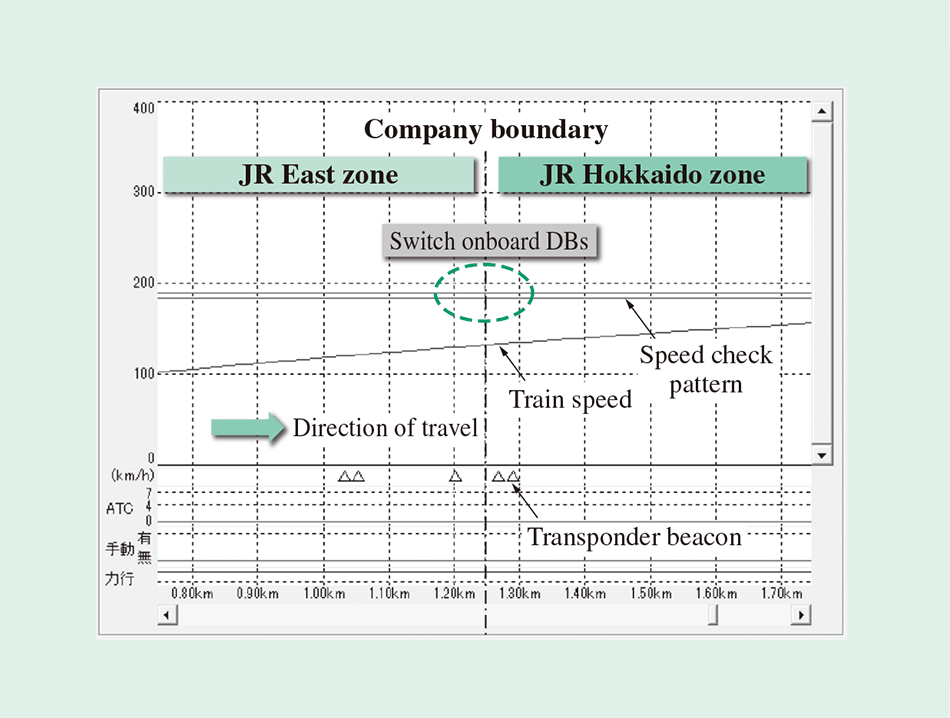To enable adaptation to new mutual through services between multiple Shinkansen train companies, the authors and their respective companies (hereafter, collectively, “we”) jointly developed two new functions for the onboard DS-ATC equipment used in Shinkansen rolling stock. One function divides the onboard DB (containing speed check patterns) into separate DBs managed independently by each train company, and the other function handles switching from one onboard DB to another while crossing company boundaries. Since the onboard DBs are an important safety element, we started by creating an organizational structure for building them, and approached development in a coordinated manner while listening to the opinions and requests of the client companies. We then implemented the new functions while operating the system and limiting changes in the existing DS-ATC system to only minor ones. Currently, the new system is running smoothly in the mutual through services between the Hokuriku Shinkansen and Hokkaido Shinkansen companies.

Rolling Stock Technology Center, Transport and Rolling Stock Department, Railway Operations Headquarters, East Japan Railway Company. He is currently engaged in the management of propulsion systems, auxiliary power supply systems, and automatic train protection systems. Mr. Yokoyama is a certified P.E.Jp (Professional Engineer, Japan).

Rolling Stock Technology Center, Transport and Rolling Stock Department, Railway Operations Headquarters, East Japan Railway Company. She is currently in charge of the design and development of onboard automatic train protection systems.

Rolling Stock Department, Railway Operations Headquarters, Hokkaido Railway Company. He is currently in charge of the design and development of automatic train protection systems.

Rolling Stock Department, Railway Operations Headquarters, West Japan Railway Company. He is currently engaged in the management of onboard automatic train protection systems, and train information network systems.

Signalling Systems Design Department, Mito Rail Systems Product Division, Railway Systems Business Unit, Hitachi, Ltd. He is currently engaged in the management of onboard automatic train protection systems.

Signalling Systems Design Department, Mito Rail Systems Product Division, Railway Systems Business Unit, Hitachi, Ltd. He is currently in charge of the design and development of onboard automatic train protection systems.
WE have completed new development that divides the onboard database (DB) used in the Shinkansen's Digital Communication & Control for Shinkansen-Automatic Train Control (DS-ATC) system into separate DBs that are managed independently by each train company. The aim of the development was to enable adaptation to new mutual through services provided by multiple Shinkansen train companies. These new services coincide with the opening of the Seibi Shinkansen lines (a set of five Shinkansen lines, one each in Hokkaido, Tohoku, and Hokuriku, and two in Kyushu). The providers of the new services are the East Japan Railway Company (JR East), the West Japan Railway Company (JR West), and the Hokkaido Railway Company (JR Hokkaido). The onboard DS-ATC system previously managed all lines using a single DB, but with the start of the new mutual through services, we decided to upgrade the system by dividing the DB mounted in the onboard DS-ATC equipment (hereafter, onboard equipment) into separate DBs managed independently by each train company. The upgrade was necessary because each railway operator needs to take responsibility for managing its own DB, since the DB contains important safety-related data. When switching from one DB to another at company boundaries, the operating conditions require that the switch is done while traveling between stations.
This article provides an overview of how we divided the onboard DS-ATC DB into separate DBs for independent management, and describes the process for controlling the switch between DBs at company boundaries.
Fig. 1—Configuration of DS-ATC Onboard Equipment. The receiver control unit forms the core of the onboard equipment. It contains the speed check patterns (DB) for all of the track circuits that could possibly become stop positions.
The receiver control unit forms the core of the onboard equipment. It contains the speed check patterns (DB) for all of the track circuits that could possibly become stop positions.
The onboard equipment determines the train position using location information from position-correcting transponder beacons. The pulse integration values from the speed generator are subtracted from the remaining distance to continuously track the train position. Based on this train position and the stop position information in ATC messages sent from ground equipment, the system searches the DB for a speed check pattern that will stop the train by the time it reaches the stop position.
Speed check patterns for all of the track circuits that could possibly become stop positions are stored in the DB in advance. These speed check patterns account for factors such as the line's slopes and curves, speed limits when traveling through branch points, and the train's brake performance (see Fig. 1).
The aims of the development are shown below.
Fig. 2—Onboard DBs Mounted in Hokuriku Shinkansen Rolling Stock. Both the JR East and JR West DBs were mounted.
Both the JR East and JR West DBs were mounted.
Fig. 3—Onboard DBs Mounted in Hokkaido Shinkansen Rolling Stock. Both the JR East and JR Hokkaido DBs were mounted.
Both the JR East and JR Hokkaido DBs were mounted.
In the past, trains in the JR East jurisdiction were managed using a single DB, and the DB information for all of the Shinkansen rolling stock owned by JR East had to be modified when updating the DB. However, using this single-DB system after the start of mutual through services would have had a major impact. Updating the DB at a single location in the JR East jurisdiction would have required the DBs for all of the areas of other companies to be updated too, because the geographic version information (information used to link ground equipment and DBs) sent from ground equipment in ATC messages needs to be updated for all areas at the same time. To avoid this problem, we decided to divide the DB into separate DBs managed independently by each company, to prevent one company from affecting other companies when it updates its DB.
Specifically, the single DB used previously was divided into three DBs, the JR East zone DB (hereafter, JR East DB), the JR West zone DB (hereafter, JR West DB), and the JR Hokkaido zone DB (hereafter, JR Hokkaido DB). However, to enable switching from one DB to another while traveling across the boundary shared by two companies, the speed check pattern data for a fixed range before and after the company boundary has to overlap and be shared by both companies.
The memory capacity of the old MEM boards is too low to accommodate all of the DBs for JR East, JR West, and JR Hokkaido, so they cannot store all of the speed check patterns. In addition, since each MEM board also needs to store the old DB on one side and the new DB on the other, we developed new MEM boards with four times the capacity of the old ones.
The new MEM boards were allocated to each company so that each onboard equipment system is equipped with two boards. The JR East DB was mounted on one board, and the JR West DB or JR Hokkaido DB was mounted on the other (see Fig. 2 and Fig. 3).
To enable switching from one DB to another at a company boundary, company ID information was added to the ATC messages sent from ground equipment. The onboard equipment identifies the train position from the logic unit number (a number uniquely identifying each station) and the track circuit number contained in the ATC messages. When the DS-ATC system was developed around 2000, however, the developers did not anticipate multiple-operator service involving companies other than JR East, so they did not leave any logic unit numbers available, preventing logic unit numbers from being allocated for JR West and JR Hokkaido zones. This problem was solved by adding company ID information to unused bits in ATC messages. This added information is used to distinguish JR East (the home company) from other companies (outside companies). The onboard equipment was also upgraded to identify the train position (station on the track) from the set consisting of the company ID information and the logic unit number in ATC messages. Similarly, since the logic unit number is also used for position-correcting transponder beacon messages, company ID information was also added to unused bits in those messages.
Adding company ID information has enabled multiple-operator service between companies, while keeping both ground equipment and onboard equipment modifications to a minimum.
An overview of the process used to control the switching of DBs at company boundaries is shown below. Through service from JR East to JR West is used as an example.
When the onboard equipment is started, the train is in the JR East zone, so the ATC messages received from the ground equipment contain “Home company” as the company ID information. The onboard equipment selects the JR East DB, and searches it for the speed check pattern that matches the in-zone logic unit number and stop logic unit number in the ATC message (see Fig. 4). The onboard equipment uses the geographic version information in the ATC message to determine whether to select the old or new JR East DB.
When the train is in the JR East zone, the ATC messages it receives always contain “Home company” as the company ID information, and the onboard equipment continues to use the JR East DB (see Fig. 5).
When the train enters the JR West zone (an outside company zone) from the JR East zone, an ATC message containing “Outside company” as the company ID information is received from the ground equipment. Since the company ID information has switched to “Outside company,” the onboard equipment switches the current onboard DB from the JR East DB to the JR West DB, and uses this DB to search for the speed check pattern that matches the in-zone logic unit number and stop logic unit number in the ATC message (see Fig. 6).
To prevent accidental DB switches at locations other than company boundaries, the DBs contain preregistered information specifying the track circuits at which switching DBs is permitted. This information enables the onboard equipment to accurately determine whether switching DBs is permitted on the current track circuit. The onboard equipment is designed to discard the ATC message (and not switch DBs) if the message contains different company ID information even though the train has not crossed a company boundary.
The onboard equipment always checks the company information in the ATC message against the preregistered company information in the onboard DB. So, if the DB has not been correctly switched to another DB after crossing a company boundary, the company information in the ATC message and onboard DB will not match, which will result in the detection of a failure with checking error and the output of an emergency brake command.
Fig. 4—Control Process when Onboard Equipment is Started. The speed check pattern matching the ATC message is retrieved from the DB and used for control.
The speed check pattern matching the ATC message is retrieved from the DB and used for control.
Since the area in the JR East jurisdiction was previously managed by a single DB, updating the geographic version in ATC messages for all areas at once required updates to the DBs of all Shinkansen rolling stock (including trains that did not provide multi-operator service to locations updated in the DB). The divided DB management approach we developed was used to divide the previous single jurisdiction into four zones (Northern Tohoku, Southern Tohoku, Joetsu, and Hokuriku), which enabled the switching of DBs at zone boundaries. Since the company ID information in ATC messages is set to “Home company” (JR East) in all areas in the JR East jurisdiction, enabling switching of DBs at zone boundaries required the geographic version information in ATC messages to be set individually by zone in the ground equipment instead of being set for all areas at once.
This change has eliminated the need to update the DBs of trains that do not provide multiple-operator service to locations updated in the DB when updating DBs in the JR East jurisdiction, which greatly reduces the DB update workload.
We mounted the developed product in a test train, and subjected it to testing on regular service routes. Since the test pre-dated service into outside company zones, it was done at the boundaries of the four zones into which the JR East region has been divided. A total of 48 DB switches were performed over 6 days at zone boundaries between Morioka station and Kitakami station on the Tohoku Shinkansen line. We obtained good results, confirming that the DB switching operations could be done as specified. Because the process of switching DBs at zone boundaries is equivalent to switching DBs at company boundaries, the results indicate that it will be possible to perform these operations normally at company boundaries also.
Fig. 7—Hokuriku Shinkansen Travel Data (Onboard Equipment Log Data Readout). The image shows a DB switch taking place as the train travels across a company boundary between the JR East and JR West zones.
The image shows a DB switch taking place as the train travels across a company boundary between the JR East and JR West zones.
Fig. 8—Hokkaido Shinkansen Travel Data (Onboard Equipment Log Data Readout). The image shows a DB switch taking place as the train travels across a company boundary between the JR East and JR Hokkaido zones.
The image shows a DB switch taking place as the train travels across a company boundary between the JR East and JR Hokkaido zones.
The opening of the Kanazawa route on the Hokuriku Shinkansen line in March 2015 marked the start of through service from the JR East zone to the JR West zone, and the start of the DB switching control process we developed. Through service to the JR Hokkaido zone started in March 2016 with the opening of the Hokkaido Shinkansen line's route to Shin-Hakodate-Hokuto station, and operation has been successful to date (see Fig. 7 and Fig. 8).
To adapt to the new mutual through services provided by multiple Shinkansen train companies, we completed new development that divided the existing single DB into separate DBs managed independently by each company.
This work required overcoming challenges such as a shortage of memory capacity in the existing MEM boards, and the lack of ATC message information to differentiate between the home company and outside companies. Ultimately, we needed to construct both new hardware and a new system, including new MEM boards, and also a way of adding company ID information to ATC messages for both onboard and ground equipment. This work ensured that the DBs of outside companies are not affected when the home company DB is updated, and that the number of trains affected by DB updates is kept to a minimum.
It is also worth noting that we were able to implement the new functions while operating the system and limited changes in the existing DS-ATC system to only minor ones.
Many parties lent their efforts to make this development possible, not only in technical areas, but also in areas such as database management, coordination between companies, and testing on service trains. The authors would like to once again express their gratitude to all those involved from the East Japan Railway Company, the Hokkaido Railway Company, and the West Japan Railway Company.